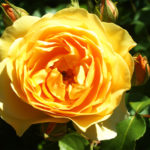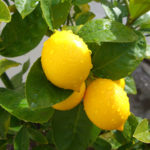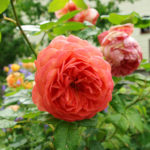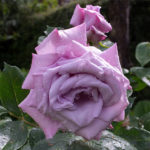Rose Benjamin Britten
David Austin's English roses, known in the world of rose growers as Ostinki, cannot be confused with any others. These beautiful creatures combine the curvaceous shapes and scent of ancient varieties with the re-blooming of modern species. And sometimes, among the most beautiful roses, it is very difficult for a florist to find that one, unique and charming one. But if you want to bring an element of romance and nostalgia to your garden, and at the same time add a bright touch that will help set off the delicate color shades of other varieties, take a closer look at Benjamin Britten.
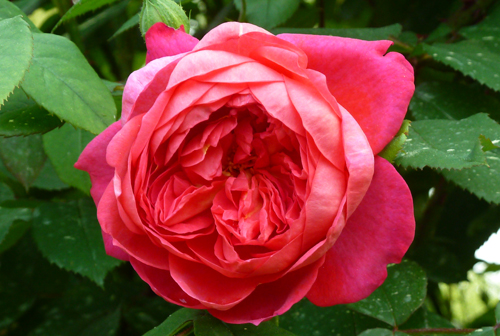
History of creation
Breeding such an exquisite flower as a rose is quite exciting, but troublesome. It sometimes takes many years before the final result meets expectations. Our hero appeared in England, belongs to the Austin rose-growing company. Breeding work began in 1992 when the rose seed Charles Austin (Ausfather) was crossed with the pollen of an unnamed seedling. The seeds obtained as a result of this experiment were sown in 1993, and of the large number of plants obtained, only one was considered the most promising. It was his 6 buds that were grafted onto the rootstock of the Rosa laxa (Rosa laxa). As a result, a seedling appeared, which was assigned a unique letter code AUSencart, and it was he who in 1995, after additional tests carried out, was selected for further breeding. David Austin decided to give the new variety the name of the famous English composer, conductor and pianist Benjamin Britten. It was under the name Benjamin Britten that the novelty was presented in the UK in 2001. According to some reports, our hero in 2005 was awarded an honorary diploma from the Australian National Trials.
Description
Benjamin Britten belongs to scrubs, that is, to shrub varieties. The plant has good vigor. An adult bush is quite powerful, erect, as a rule, does not need support, dense, due to strong branching, densely leafy. The height is stated to be average, about 100 - 120 cm, but cases are not uncommon, especially in warm regions, when the height reaches 200 cm. According to some reports, the variety has a tendency to climbing. The perennial is approximately equal in width to its height - from 75 to 100 cm, therefore, during the growing season, the bush looks quite harmonious. Although some growers call it somewhat sloppy because of its strong branching. Shoots are not thick, covered with thorns. The foliage is healthy, elegant, light green. Young leaves with a reddish tint. Leaves are small, pinnate, oblong leaf blade, serrated edge and slightly shiny surface. On the stem, both individual flowers and small inflorescences, usually consisting of 3 buds, can appear.
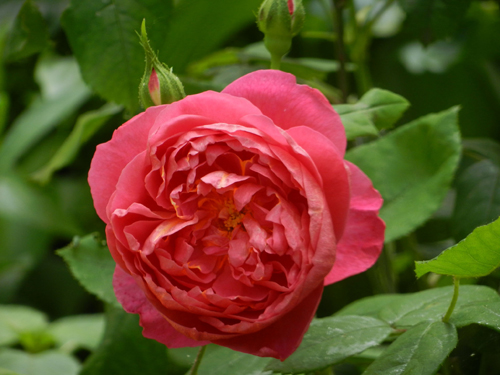
The gorgeous flower of this rose consists of 41 or more petals, therefore it belongs to the densely doubled. But, despite the large number of petals, the opened rosette looks very light. The shape is deeply cupped, with deep-set petals. But in the process of dissolution, it changes to a wide-bowl, while the longer outer petals are bent back, and the center is filled with randomly located small petals. In full dissolution, a bright yellow center is visible, which creates an amazing color effect, which makes the flower appear to be illuminated from the inside. The size of the rosette is average, from 10 to 12 cm, however, there is information that sometimes the diameter of the rose does not exceed 8 cm. The color, according to many rose growers, is atypical for most ostins. The bold red tones of the petals play with shades of orange-brick or pale salmon. As the dissolution progresses, the color scheme goes into a crimson spectrum.
Flowering period
Benjamin Britten is a multi-flowering variety. The flowering period is often limited to two long waves, between which single flowers appear.The first wave of flowers is very abundant, starting in early or mid June, depending on the region. The second wave is marked by a more modest, but no less spectacular flowering and begins around late summer - early autumn. The buds continue to grow until the onset of cold weather. The decorative period of a single flower is quite long, it can last a week or longer. The masterpiece by David Austin has a beautiful and intense aroma reminiscent of fruity, with hints of wine and sweet pear.
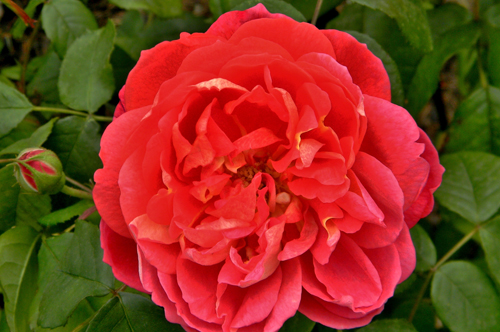
Fading rosettes make the perennial somewhat untidy, so they need to be cut off in time. This increases not only the decorative effect of the culture. The plant has an incentive to form new buds. According to the reviews of flower growers, Benjamin Britten practically does not crumble in the process of flowering, the rosette simply dries up on the shoot. Thus, the soil under the bush always remains clean.
Characteristics
- Already in the second year after planting, one can appreciate not only the vigorous growth rate of the shrub, but also its spectacular, abundant and bright flowering;
- the perennial is quite winter-hardy, which is greatly facilitated by the Lax stock. The declared degree of frost resistance makes it possible to grow crops in zone 5 USDA (according to the system adopted by the US Department of Agriculture). This means that the plant can easily overwinter at temperatures ranging from minus 23.3 to minus 28.9 ° C. Thanks to such indicators, flower growers from many regions of Russia were able to grow this masterpiece in their garden;
- immunity is excellent. Our hero shows high resistance to the main diseases of the culture - black spot and powdery mildew, even in unfavorable periods. The good health of the rose is also confirmed by numerous approving reviews of flower growers. Of the pests, aphids can cause a lot of troubles in the hot period;
- in addition, the plant can withstand high temperature indicators in the summer, therefore, in addition to cool regions, it grows well in hot ones;

- resistance to rain is average. This means that some flowers can be damaged during the rainy season, and rotten buds are not destined to open. But in general, rose growers note that the culture is recovering well even after prolonged rains.
Agrotechnics
According to experts, Benjamin Britten tolerates spring planting best. After the autumn procedure, in the event of an unfavorable winter, a fragile seedling may suffer. The culture prefers well-lit, sunny places, but in partial shade, especially in the southern regions, it feels very good. But a dense shadow will negatively affect decorativeness, the flowers will be small, the flowering is not so lush. The plant is not particularly picky about the soil, on the Lax rootstock it is able to quickly adapt to alkaline soils. But, of course, it shows the best results on loose and nutritious loams with neutral acidity. In leaving, our hero is not capricious. But he needs timely watering, feeding 2 - 3 times during the growing season and timely preventive treatment against diseases and pests. Pruning, despite the fact that the bush is quite harmonious, is still required. In the spring, you need to remove old and frozen branches, thin out the crown, cutting off the shoots growing inside the bush. Correct pruning will help to form a multi-tiered flowering perennial and hide possible exposures in its lower part. When planting, it should be borne in mind that the shrub grows strongly, and experienced flower growers recommend planting no more than 2 bushes per 1 square meter.
Rose Benjamin Britten is appreciated by flower growers, she perfectly combines feminine tenderness and firm masculine character. This is a truly reliable plant that can forgive a novice gardener for minor care errors.Despite the bright colors of our hero, he does not suppress many other color shades, but makes a single whole with them. Therefore, it is good to plant it not only solo, but also in compositions. The variety goes very well with conifers or hosts, which are planted at the foot of the bush. Other pink varieties created by David Austin are considered the best companions. Taking care of the culture is not difficult, but rather inconvenient due to the numerous thorns.
